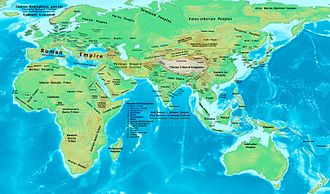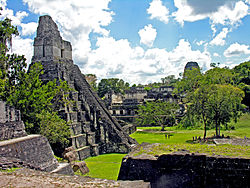

| Millennia |
|---|
| 1st millennium |
| Centuries |
| Timelines |
| State leaders |
| Decades |
| Categories: |
| Births – Deaths Establishments – Disestablishments |
The 4th century was the time period from 301 CE (represented by the Roman numerals CCCI) to 400 CE (CD) in accordance with the Julian calendar. In the West, the early part of the century was shaped by Constantine the Great, who became the first Roman emperor to adopt Christianity. Gaining sole reign of the empire, he is also noted for re-establishing a single imperial capital, choosing the site of ancient Byzantium in 330 (over the current capitals, which had effectively been changed by Diocletian's reforms to Milan in the West, and Nicomedeia in the East) to build the city soon called Nova Roma (New Rome); it was later renamed Constantinople in his honor.
Contents
The last emperor to control both the eastern and western halves of the empire was Theodosius I. As the century progressed after his death, it became increasingly apparent that the empire had changed in many ways since the time of Augustus. The two-emperor system originally established by Diocletian in the previous century fell into regular practice, and the east continued to grow in importance as a centre of trade and imperial power, while Rome itself diminished greatly in importance due to its location far from potential trouble spots, like Central Europe and the East. Late in the century Christianity became the official state religion, and the empire's old pagan culture began to disappear.[ citation needed ] General prosperity was felt throughout this period, but recurring invasions by Germanic tribes plagued the empire from 376 [1] [2] CE onward. These early invasions marked the beginning of the end for the Western Roman Empire.
In China, the Jin dynasty, which had united the nation prior in 280, began rapidly facing trouble by the start of the century due to political infighting, which led to the insurrections of the northern barbarian tribes (starting the Sixteen Kingdoms period), which quickly overwhelmed the empire, forcing the Jin court to retreat and entrench itself in the south past the Yangtze river, starting what is known as the Eastern Jin dynasty around 317. Towards the end of the century, Emperor of the Former Qin, Fu Jiān, united the north under his banner, and planned to conquer the Jin dynasty in the south, so as to finally reunite the land, but was decisively defeated at the Battle of Fei River in 383, causing massive unrest and civil war in his empire, thereby leading to the fall of the Former Qin, and the continued existence of the Eastern Jin dynasty.
According to archaeologists, sufficient archaeological evidence correlates of state-level societies coalesced in the 4th century to show the existence in Korea of the Three Kingdoms (300/400–668 CE) of Baekje, Goguryeo, and Silla.



